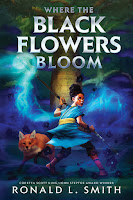January 31, 2023 by Clarion Books
E ARC provided by Edelweiss Plus
Asha lives on the continent of Alkebulan (the ancient name for Africa), where everyone gets an identifying mark when they come of age. She lives with a group of performing travelers including griots, fortune-tellers, and illusionists, since Suna took her in as a foundling. When her symbol ends up being somewhat unusual, Suna writes to a friend, Rima, to inquire about the sacred baobab tree now present on Asha's skin. Before she gets an answer, however, the community is attacked by minions of the Shrike. The results are devastating, and leave Asha and Obo, a former warrior from Enkolia, as the only survivors. They set off to locate the Underground Kingdom "where the black flowers bloom" that Suna has advised Asha to seek. They are accompanied by Sprix, who is running away from his father and has some magical secrets of his own, as well as Rima, who comes to find them after she hears about Suna's fate. Along the way, they meet various fellow creatures, like the talking Gazella who let them travel along their protected path, violent dragonflies, and more of the Shrike's forces. They finally arrive and meet the Aziza people of the Baobab circle, from whom Asha is descended. Their leader, Pulligan, greets Asha as their queen, and shares with her her heritage. The Shrike is indeed after her for complicated reasons I don't want to spoil. Will Asha be able to embrace her new role with the Aziza, and solve some of the mysteries of her past.
Strengths: This was a fast-paced, classically constructed middle grade fantasy, complete with foundling main character who ends up being the chosen one, a journey across a difficult magical landscape with a supportive crew of friends with various powers, and a fight against the forces of evil. Asha is a sympathetic and compelling character who reluctantly embraces her fate; this reminded me rather strongly of Taran's journey in Alexander's 1964 The Book of Three. It's tough to get the pacing just right on these fantasy quests, but Smith does a good job of moving the story along while also richly describing the environment and characters. There have been a lot of excellent magical academy books with Black characters lately, but we needed a good hero's quest. Asha's fits the bill nicely.
Weaknesses: In his author's notes, Smith mentions that he was a big fan of classic fantasy like Lewis' Chronicles of Narnia, but that he wanted something more reflective of his own culture than he was finding in those Anglo-Celtic myths. I would have liked a few notes on the myths and legends; it's something I wish more fantasy books in general would include. This did have a few inclusions of faeries and seelies that seemed a bit at odds with the predominately African setting; the red fox on the cover is Sprix in shapeshifting mode. Young readers won't overthink the connections the way I do, but will just enjoy the story.
What I really think: This seems like it could be a stand alone, and I'd love to see more culturally connected fantasies that aren't in long series. My students aren't huge fantasy readers, and while they might pick up one book, like Traoré's Children of the Quicksands, I haven't been able to get them to read series, like the very well written and interesting Rick Riordan Presents books. It's great to see fantasy reflecting more cultures, and so I do stock up on the books while they are available. I just wish more students read fantasy.

Weaknesses: In his author's notes, Smith mentions that he was a big fan of classic fantasy like Lewis' Chronicles of Narnia, but that he wanted something more reflective of his own culture than he was finding in those Anglo-Celtic myths. I would have liked a few notes on the myths and legends; it's something I wish more fantasy books in general would include. This did have a few inclusions of faeries and seelies that seemed a bit at odds with the predominately African setting; the red fox on the cover is Sprix in shapeshifting mode. Young readers won't overthink the connections the way I do, but will just enjoy the story.
What I really think: This seems like it could be a stand alone, and I'd love to see more culturally connected fantasies that aren't in long series. My students aren't huge fantasy readers, and while they might pick up one book, like Traoré's Children of the Quicksands, I haven't been able to get them to read series, like the very well written and interesting Rick Riordan Presents books. It's great to see fantasy reflecting more cultures, and so I do stock up on the books while they are available. I just wish more students read fantasy.


























No comments:
Post a Comment